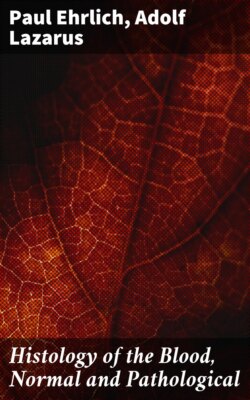Читать книгу Histology of the Blood, Normal and Pathological - Paul Ehrlich - Страница 8
На сайте Литреса книга снята с продажи.
A. METHODS OF INVESTIGATION.
ОглавлениеTable of Contents
A glance at the history of the microscopy of the blood shews that it falls into two periods. In the first, which is especially distinguished by the work of Virchow and Max Schultze, a quantity of positive knowledge was quickly won, and the different forms of anæmia were recognised. But close upon this followed a standstill, which lasted for some decades, the cause of which lay in the circumstance that observers confined themselves to the examination of fresh blood. What in fact was to be seen with the aid of this simple method, these distinguished observers had quickly exhausted. That these methods were inadequate is best shewn by the history of leucocytosis, which after the precedent of Virchow was in general referred to an increased production on the part of the lymphatic glands; and further by the imperfect distinction between leucocytosis and incipient leukæmia, which was drawn almost exclusively from purely numerical estimations. It was only after Ehrlich had introduced the new methods of investigation by means of stained dry preparations, that the histology of the blood received the impulse for its second period.
We owe to them the exact distinction between the several kinds of white blood corpuscles, a rational definition of leukæmia, polynuclear leucocytosis, and the knowledge of the appearances of degeneration and regeneration of the red blood corpuscles, and of their degeneration in hæmoglobinæmic conditions. The same process, then, has gone on in the microscopy of the blood that we see in other branches of normal and pathological histology: by advances in method, advances in knowledge full of importance result. It is therefore little comprehensible, that an author quite recently should recommend a reversion to the old methods, and emphatically announce that he has managed to make a diagnosis in all cases, with the examination of fresh blood. At the present time, after the most important points have been cleared up by new methods, in the large majority of cases, this is not an astonishing achievement. For any difficult case (for instance the early recognition of malignant lymphoma, certain rare forms of anæmia, etc.) as the experienced know, the dry stained preparation is indispensable. The object of examining the blood, is certainly not to make a rapid diagnosis, but to investigate exactly the individual details of the blood picture. To-day, we can only take the standpoint, that everything that is to be seen in fresh specimens—apart from the quite unimportant rouleaux formation, and the amœboid movements—can be seen equally well, and indeed much better in a stained preparation; and that there are several important details which are only made visible in the latter, and never in wet preparations.
As regards the purely technical side of the question, the examination of stained dry specimens is far more convenient than that of fresh. For it leaves us quite independent of time and place, we can keep the dried blood with few precautions for months at a time, before proceeding to further microscopic treatment; and the examination of the preparation may last as long as required, and can be repeated at any time. On the contrary, the examination of the wet preparation is only possible at the bedside, and must be conducted within so short a time, on account of the changeability of the blood, clotting, destruction of white corpuscles and so forth, that a searching investigation cannot be undertaken. In addition the preparation and staining of dried blood specimens is amongst the simplest and most convenient of the methods of clinical histology. In the interest of its wider dissemination, it will be justifiable to describe it more in detail.
We must also mention here the use of the dry preparation in the estimation of the important relation between the number of the red and of the white corpuscles; and also of the relative numbers of different kinds of white blood corpuscles.
For this purpose, faultless specimens, specially regularly spread, are indispensable. Quadratic ocular diaphragms (Ehrlich-Zeiss) are requisite, which form a series, so that the sides of the squares are as 1:2:3 … :10, the fields therefore as 1:4:9 … :100. The eye-piece made by Leitz after Ehrlich's directions is more convenient, in which, by a handy device, definite square fractions of the field can be obtained. The enumeration is made as follows. The white blood corpuscles are first counted in any desired field with the diaphragm no. 10, that is with the area of 100. Without changing the field, the diaphragm 1, which only leaves free a hundredth part of this area, is now put in, and the red corpuscles are counted. The field is then changed at random, and the red corpuscles counted in a portion of the area which represents the hundredth of that of the white. About 100 such counts are to be made in a specimen. The average of the red corpuscles is then multiplied by 100 and so placed in proportion with the sum of the white. If the white corpuscles are very numerous, so that counting each one in a large field is inconvenient, smaller sections of the eye-piece 81, 64, 49, etc. may be taken.
The important estimation of the percentage relation of the various forms of leucocytes is effected by the simple "typing" of several hundred cells, a count which for the practised observer is completed in less than a quarter of an hour.
